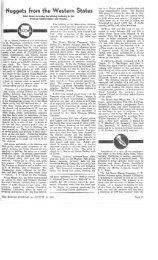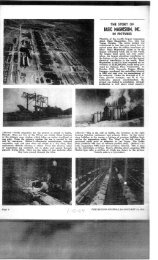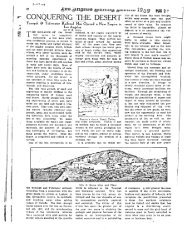A HISTORY OF THE CARRISA PLAINS Compiled by ... - Vredenburgh
A HISTORY OF THE CARRISA PLAINS Compiled by ... - Vredenburgh
A HISTORY OF THE CARRISA PLAINS Compiled by ... - Vredenburgh
You also want an ePaper? Increase the reach of your titles
YUMPU automatically turns print PDFs into web optimized ePapers that Google loves.
Page | 7<br />
The well bred horses were forgotten for many years on account of the automobile and modern farm<br />
machinery. Now, however, interest has been revived <strong>by</strong> pleasure riding and riding and roping clubs. The<br />
saddleite Club of Carrisa Plains is one of these.<br />
Mrs. Latimer, a daughter of Chester R. Brumley, of the Painted Rock Area, relates an interesting story<br />
concerning her attempt to capture and break two antelope to pull a buggy. It was her ambition at one<br />
time while she lived on the Plains to drive down the streets of San Luis Obispo driving a team of<br />
antelopes. Her ambition was never realized. She failed to raise to maturity the two antelopes which she<br />
had captured.<br />
Agriculture on the Carrisa Plains<br />
There are approximately 500,000 acres of land included in the Carrisa Plains. The principal agricultural<br />
products from this land are wheat, barley, cattle and sheep.<br />
The earliest settlers raised sheep then soon turned to cattle. The grain that seemed to thrive so well in<br />
the rich soil was fed to livestock which would be driven to market and there<strong>by</strong> furnish their own<br />
transportation which was difficult in those days. Later when transportation and roads improved, the<br />
golden grain which was mostly wheat was sacked and taken to market in three or four team wagons.<br />
Finally around 1929, when trucks were improved the train was transported <strong>by</strong> the bult (sic) method. It<br />
was no longer sacks.<br />
When government restrictions on wheat began the grain ranchers turned their attention to the<br />
production of some barley.<br />
The ranchers soon learned that planting a field every other year increased the yield and conserved the<br />
moisture in the soil. It is difficult for some mid-western visitors to believe that so much moisture exists a<br />
few inches down in the soil when it gets so little rainfall. The rainfall averages from eight to ten inches<br />
annually.<br />
Very little irrigation is practiced because of irrigation installation costs. Some ranchers successfully<br />
raised potatoes until the prices went down and larger growers made it difficult to sell a crop. However,<br />
some alfalfa, maize, and other crops are irrigated and the crop fed locally.<br />
Visitors driving along the road occasionally see bee hives setting in the fields. These bees collect the<br />
honey from the sage and turpentine weed. Special trucks with booms load the hives and move them to<br />
different locations. Rent is generally paid to the ranchers in honey.<br />
Although grains grow readily, weeds do too. Along with water the weeds are one of the grain ranchers’<br />
major problems. They especially dislike the Russian thistle which the Hessian soldiers brought to this<br />
country when they were hired <strong>by</strong> the British during our country’s fight for freedom. At least for the past<br />
six or seven years the crop duster has come to the Plains. When the wheat is a few inches high, they<br />
appear early in the morning spray with a weed killer.















